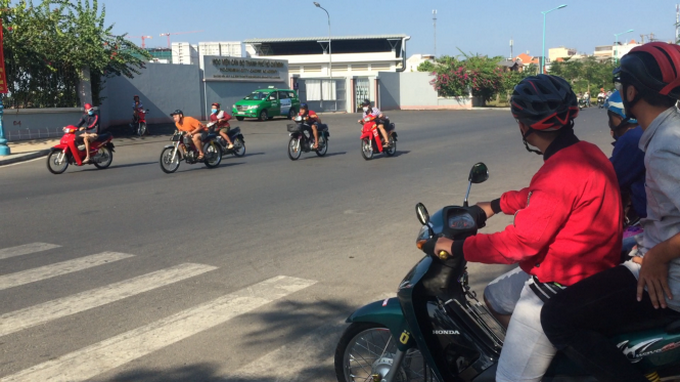About 2,900 street racers were recorded by traffic police in Ho Chi Minh City during the first quarter of 2016, raising questions about the effectiveness of the city’s measures to curb the dangerous hobby among young Vietnamese.
In Vietnam, people refer to those who participate in illegal street racing as ‘monster riders’ for the risk they pose not only to themselves but also to other commuters.
Tuoi Tre (Youth) newspaper reporters followed a group of these so-called ‘monster drivers’ at the height of a recent police crack-down.
After several days of tailing the group, the reporters noted that there are races now organized during daylight hours, whereas previously they only occurred late at night.
The reporters contacted one monster rider named N. by phone, who simply said, “Just come to the embankment at 2:00 pm and you will see the ‘storm’.”
To ‘go storming’ is the local slang for a large gathering of the group, who essentially march the streets on motorbikes.
While it is usually in celebration of a significant event, the term carries a mostly negative connotation, being connected to the dangerous ‘sport’ of street drag racing.
After moving from one place to another in avoidance of the police, one group of street racers settled on Truong Sa Street, which runs along a channel embankment across a number of districts in the city, as the place to indulge their dangerous habit.
Dozens of cheerleaders pulled over to the side of the street to make way for the monster riders, who lined up abreast of each other in the middle of the road. Revving the engines of their modified motorbikes, they then darted forward at full speed, ignoring the presence of regular commuters.
As some monster riders revealed, these ‘storms’ are organized at a different place every time and only last from five to ten minutes to avoid drawing attention from the police.
When ambushed by authorities, the street racers simply take off in different directions each time so as to confuse and overwhelm officers.
Answering the reporters’ questions on why they dared to race during the day, some racers said that they would only race on uncrowded streets on Sunday afternoons, when the presence of police is reduced.
“The police try to ambush us at night, so we move the races to earlier time slots once in a while. They can still get notified about the races, but without preparation it’s very hard for them to catch us,” T., one monster rider, said.

A police squadron camping on Hanoi Highway in Thu Duc District, Ho Chi Minh City on March 31, 2016. Photo: Tuoi Tre
At about 9:00pm on March 30, a group of police officers had been camping out at an intersection in District 5 for hours in an unsuccessful attempt to catch the street racers.
“They normally send out a ‘scout’ to survey the streets before gathering in large numbers for a race,” one of the officers at the camp said. “Though we don’t catch many, our presence helps keep these races under control and pacify local residents.”
At another police camp at a busy intersection dividing District 5 and District 10, many young riders who looked suspicious were pulled over for administrative checks.
Officers tested the level of alcohol concentration in their breath and inspected the structure of their motorbikes for any illegal modifications.
Over the course of only 30 minutes, dozens of riders received tickets and had their motorbikes confiscated.
An officer at the camp said some of these riders were repeat violators who had been caught in multiple ‘storms’ before.

Riders pulled over for administrative checks on Hanoi Highway in Thu Duc District, Ho Chi Minh City on March 31, 2016. Photo: Tuoi Tre
According to Huynh Trung Phong, deputy head of the Division for Road and Railway Traffic under Ho Chi Minh City Police, the division gave tickets to 2,909 violators of traffic safety rules including moving in large groups, biking abreast, and noise violations in the first quarter of 2016 alone.
Phong said that even though the number of races has decreased in recent years, their operations have become more complex and organized.
“We have cooperated with other police divisions to establish a network of underground coordinators to track and follow objects under scrutiny, in addition to holding talks on topics of traffic safety at schools in the city,” Phong was quoted as saying.
Dr. Truong Van Vy, a professor who teaches criminal sociology at the Vietnam National University-Ho Chi Minh City, regards engagement in street racing as a deviant behavior that defies social rules.
“The most effective measure is to teach youngsters about morality and culture. When they are aware that such behaviors are wrong, they will stop participating in the act,” Dr. Vy said.
Meanwhile, Professor Vu Gia Hien, who holds a PhD in psychology, and is director at the Center for Cultural and Tourist Research and Application, said that the need to participate in street races is a reality among youths who have a thirst for risk.
“These youths need healthy adventure sports to satisfy their needs, otherwise they will organize spontaneous street races which pose a danger to the community,” Hien explained.
Like us on Facebook or follow us on Twitter to get the latest news about Vietnam!






















































